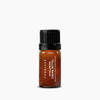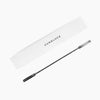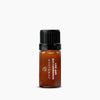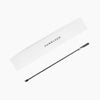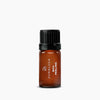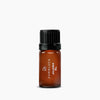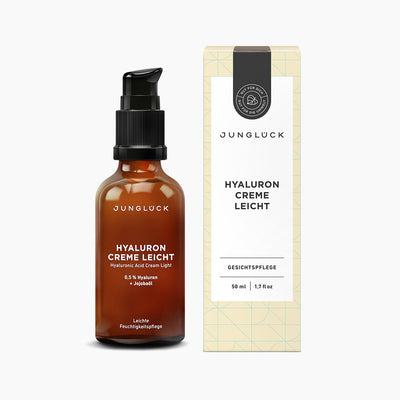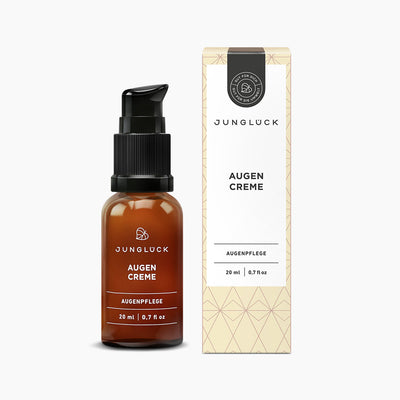
September 6, 2021
Hyaluronic acid - An acid for the skin?
by Mara Hageneier
We generally associate acids with highly corrosive liquids that we would rather avoid coming into contact with our skin. So you wouldn't actually think that hyaluronic acid is the "Holy Grail" of skincare. But we have the wrong first impression. Hyaluronic acid is a relatively weak, organic acid that is not harmful to skin, which is also slightly acidic - on the contrary. In this article, you can find out exactly what this active ingredient is and why it lives up to its image.
It all starts with getting to know hyaluronic acid and its chemical structure
If we really want to get to know hyaluronic acid, we should take a closer look at its chemical structure. We quickly realize that the acid is not actually that unappealing: hyaluronic acid can be imagined as a long string of pearls in which units of two sugar molecules are strung together. For the scientists among us: hyaluronic acid is a polysaccharide and consists of a long chain of repeating disaccharide building blocks.
A hyaluronic acid chain can consist of up to 50,000 of these building blocks. The individual chains attract each other and thus form a close-meshed network. Like a kind of sponge, hyaluronic acid is therefore able to bind and store large quantities of water.
 Hyaluronic acid - a natural component in our body
Hyaluronic acid - a natural component in our body
The body makes use of this property by producing hyaluronic acid itself and using it where a lot of water needs to be retained. For example, in the vitreous humor of the eye, which consists almost exclusively of water and 2% hyaluronic acid.
Hyaluronic acid also plays an important role for our joints: together with the water stored in it, it is an excellent lubricant and shock absorber.
However, the largest proportion is found in the intercellular spaces of the skin. It forms a gel-like matrix in the dermis, in which the collagen fibers and fibroblasts are embedded. Together with these proteins, hyaluronic acid is responsible for the structure and elasticity of the skin. In the skin, hyaluronic acid is formed from glucose by very specific cells with very specific proteins. It is an amazing piece of machinery that takes place in our body every day.
Hyaluronic acid supplies our skin with moisture down to the deeper layers and stores the water in so-called moisture depots - making the skin appear plump and wrinkle-free. The optimum supply of moisture to the skin allows the cells to be supplied with important nutrients and waste products to be efficiently removed. This is how hyaluronic acid works anti-inflammatory and prevents blemishes. But that's not all: the depots Treat also act as a natural skin shield and make the skin resistant to external influences such as UV radiation, environmental toxins or mechanical irritants. It's quite an avalanche that hyaluronic acid sets in motion.
Over time, however, the body's natural hyaluronic acid production decreases: women up to the age of 45 still have a concentration of around 0.03%, while a 60-year-old woman only has 0.015%. As the concentration decreases, so does the skin's moisture content. Normally, our healthy, intact cornea has a water content of around 20%. However, if it falls below 10%, the skin becomes dry and irritated. The skin becomes flabbier and the first wrinkles appear. The body's own hyaluronic acid production can also decrease slightly in younger people due to stress or environmental influences.
 Hyaluronic acid from the outside - the moisturizing effect
Hyaluronic acid from the outside - the moisturizing effect
So it makes sense to give our skin a little helping hand and treat it with hyaluronic acid Moisturize. By applying apply to the skin, hyaluronic acid is absorbed into the uppermost cell layers and the skin is thus supplied with moisture. The skin regains volume, appears firmer and wrinkles are reduced. This effect can even be measured: The scientific term for the amount of water that evaporates through the skin is transepidermal water loss. The lower this value, the less water is lost. Sounds logical and achieves measurable results. A study by the Clinic and Polyclinic for Dermatology and Allergology at the Ludwig-Maximilians-University in Munich was able to prove the effectiveness of hyaluronic acid. The study showed that the use of 0.1 percent hyaluronic acidcream achieved a significant improvement in skin hydration and general suppleness compared to a placebo. However, not all hyaluronic acid is the same. I will explain the difference in the next section.
Incidentally, hyaluronic acid is not only a great moisturizer for the skin, but also for the hair. In our hair care line we have therefore used it deliberately - wavy and curly hair will be particularly pleased!
Hyaluron is not just hyaluron - the size determines the effect
Many studies indicate that the effect of topical applications of hyaluronic acid depends on the size of the fragments. This is because not all hyaluronic acids are the same. They are classified as either high molecular weight or low molecular weight hyaluronic acids, which differ in their molecular size. The classification is based on the molecular mass, which is given in the unit "dalton" or "kilodalton".
While hyaluronic acid is usually present in the body as a long-chain compound with a high molecular mass, smaller fragments are used in cosmetics.
High-molecular hyaluronic acid - lies on the skin
High-molecular hyaluronic acid consists of molecules with a size of 1500 kDA or more. Although they cannot penetrate the skin barrier, they form a thin film on the skin. This prevents the skin's own water from evaporating too quickly and thus increases the skin's hydration.
Unfortunately, the film is washed off relatively quickly, so it should be reapplied daily.
Low-molecular hyaluronic acid - absorbs into the skin
This hyaluronic acid consists of molecules in the size of 50 kD and smaller. Its moisture-binding properties properties are less pronounced. However, as they can penetrate deeper into the epidermis, moisture is retained for longer and the skin is effectively moisturized.
Oligo-hyaluronic acid - absorbs deepest into the skin
This type uses extremely short-chain molecules. These are many times smaller and can penetrate even deeper into the skin. While the larger molecules remain in the horny layer, the presence of the smallest molecules in the epidermis has been demonstrated.
The effect of hyaluronic acid of different molecular masses was also investigated in a study by the Ludwig Maximilian University of Munich. The use of creams with low-molecular hyaluronic acid was shown to lead to a significant reduction in wrinkle depth, an effect that can be explained by the deeper penetration capacity of the smaller molecules.
 The effect of hyaluronic acid on the skin - an overview
The effect of hyaluronic acid on the skin - an overview
- increases the moisture content of the skin
- counteracts skin ageing by delaying the formation of wrinkles
- Can reduce the depth of existing wrinkles
- Improves skin elasticity
- reduces the feeling of tightness in the skin with various skin conditions such as eczema or neurodermatitis
- Effective against skin redness and burns
This means that hyaluronic acid is literally floating in cosmetic heaven and certainly lives up to its standing. But caution is still advised!
Transparency in the cosmetics sky - the not-so-dark underbelly
With all this flattery, you could be a little skeptical. And indeed, there is a small drop of bitterness - even our dear hyaluronic acid is not without its downsides. In principle, hyaluronic acid is very well tolerated, as it occurs naturally in our skin and in many organs. Its use in humans therefore seems ideal in principle. Nevertheless, you should take a closer look at it and not just pick it up at random.
Molecules with a molecular weight of 5 kD or more can reach the deeper layers of the skin. This is positive in itself, as it allows the products to have the best effect. However, if unwanted ingredients from the cosmetics or bacteria from the surface of the skin enter the cells with the molecules, inflammation and skin irritation could be promoted. However, if the molecules are chosen in the right size range, this flaw can be easily avoided.
It is therefore advisable to sharpen your focus and pay a little attention to the list of ingredients. Unfortunately, the INCI designation does not make it clear which variant it is. In the cosmetic ingredients, the so-called INCI, all variants are called Sodium Hyaluronate. If you want to know more details, it is best to ask the manufacturer directly. It is also worth asking where the miracle molecule actually comes from. This is because the exact production process is not clearly stated in the INCI designation. I will explain the differences in the next section.

Hyaluronic acid - where does it actually come from?
By now we should have an idea of why hyaluronic acid is no longer considered the SECRET weapon among active ingredients. Hyaluronic acid can now be found almost everywhere as an ingredient in cosmetic products. Demand has increased considerably since its discovery. Who would want to do without this miracle ingredient? But as is so often the case, happiness doesn't just fall into your lap. You have to put in a little effort to reap the benefits of hyaluronic acid.
Hyaluronic acid must be produced in large quantities to meet the increasing demand. Two different methods are used today. In the cheap version, it is obtained from natural sources, namely from the combs of roosters. However, the hyaluronic acid obtained in this way can still be contaminated with proteins from these animals. Some people react to these proteins with allergic reactions, including allergic shock. In addition, all products of animal origin also carry a certain risk of transmitting pathogens to humans. One way out of this dilemma is biotechnological production. Hyaluronic acid is obtained through bacterial fermentation: The bacteria are modified in such a way that they biochemically synthesize hyaluronic acid in a highly pure form and quality. Our hyaluronic acid molecules are also obtained by fermentation with bacteria from peptones in wheat and molasses. As a result, the products contain no allergens, pesticides or nanomaterials. They do not come into contact with raw materials or products from animal sources.
Mix & Match - Know how!
The science behind hyaluronic acid doesn't seem to be that simple and if you've been confused or confused by my article so far, you can now relax a little. In our hyaluronic acid Concentrate , we have made sure that all hyaluronic acid variants are optimally combined so that your skin is provided with an all-round package. Long-chain (2200 kDa), medium-chain (1500 kDa) and short-chain (30 kDa) hyaluronic acids are on the list of ingredients in our formula - and in a concentration of 1.4%. This means you benefit from both short-term and long-term results without stressing your skin with possible side effects. The Concentrate is ideal as basic care in the morning. If you want to moisturize your skin even more and prepare it for the day, I also recommend our Hyaluron cream medium . Especially if you have dry skin, you should not do without the low-molecular hyaluronic acid it contains in a concentration of 0.5%.
Even in the evening after confronting endless environmental influences, you should reward your protective skin barrier with a little attention. Our Hyaluronic Acid Night Cream with 0.3% low-molecular hyaluronic acid regenerates and gives you new energy for the next day.
As all products are water-based, you run no risk of sealing your skin with a greasy film. In combination with aloe vera, you give your skin a real moisture boost and get the protective and strengthening metabolic pathways rolling.
You can also combine hyaluronic acid with almost all other active ingredients. It works particularly well with retinal or fruit acids - they deeply moisturize the skin and give it a fresh glow.
It is important to realize that the effect of hyaluronic acid is purely cosmetic and does not prevent skin aging. Unfortunately, the aged skin is not renewed in this way, it is only temporarily plumped up. Regular use of hyaluronic acid is therefore necessary to keep the skin firm.
Nourishes without being greasy & provides the skin with intensive moisture
33,90 €
incl. VAT, plus shipping
678,00 € / 1l
33,90 €
incl. VAT, plus shipping
678,00 € / 1l
33,90 €
incl. VAT, plus shipping
678,00 € / 1l
33,90 €
incl. VAT, plus shipping
678,00 € / 1l
33,90 €
incl. VAT, plus shipping
678,00 € / 1l
33,90 €
incl. VAT, plus shipping
678,00 € / 1l
39,90 €
incl. VAT, plus shipping
1.995,00 € / 1l
39,90 €
incl. VAT, plus shipping
1.995,00 € / 1l
Hyaluron boost from within - is a dietary supplement useful?
It is now not only the cosmetics industry that has jumped on the hyaluronic acid bandwagon. As beauty is a lucrative market, there is also a focus on hyaluronic acid as a dietary supplement, whether in the form of capsules, powders, tablets or drinks. Such products are often advertised as having a positive effect on the skin. However, it is unclear exactly how hyaluronic acid is metabolized in the body in this way.
It is extremely doubtful whether hyaluronic acid taken orally as a dietary supplement survives digestion in the gastrointestinal tract and passage through the liver and reaches the wrinkles in the skin or the hair. According to everything we know about the anatomy and physiology of the digestive tract, hyaluronic acid is either excreted as indigestible polysaccharides or broken down into short-chain fatty acids by bacteria. This means that they are available to the body as fatty acids, but not as hyaluronic acid. Against this background, it currently seems absolutely unlikely that hyaluronic acid intake with food would have a positive effect on the body.
In contrast to topically applied hyaluronic acid, i.e. hyaluronic acid products applied to the skin, the study situation is extremely scarce. Advertising claims such as "for young skin" or "for good skin hydration" have not been scientifically proven by the European Food Safety Authority (EFSA). It is therefore worthwhile not to trust the advertising industry without exception.
Hyaluronic acid - our very own water magnet
After all the science, it's time to give hyaluronic acid its well-deserved applause. With its impressive effectiveness, it is absolutely in the fast lane and leaves many other active ingredients in the slipstream. As an endogenous substance, almost everyone can tolerate it and even sensitive skin can benefit from properties . And quite honestly - we are happy to accept the small stumbling blocks. Because if you look long enough, you will almost always find a fly in the ointment. If you pay attention to regular use and choose the right products, you won't want to do without your hyaluronic acid routine in the bathroom.

Sources
https://pubmed.ncbi.nlm.nih.gov/22052267/
https://pubmed.ncbi.nlm.nih.gov/33090687/
https://pubmed.ncbi.nlm.nih.gov/32173915/
https://pubmed.ncbi.nlm.nih.gov/17177600/
https://www.meduni.com/wissenschaftliche-studien-zur-wirkung-von-hyaluronsaeure/
https://www.verbraucherzentrale.de/wissen/lebensmittel/nahrungsergaenzungsmittel/ist-hyaluronsaeure-gut-fuer-haut-und-gelenke-28509
https://www.springermedizin.de/
Pavicic T, Gauglitz GG, Lersch P, et al. Efficacy of cream-based novel formulations of hyaluronic acid of different molecular weights in anti-wrinkle treatment. J Drugs Dermatol. 2011;10(9):990-1000.


